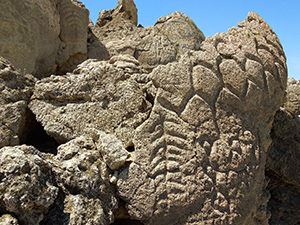|
The Discovery of Old Carvings in Nevada May Link to the First Peopling of the New World
by Leila Fletcher, age 11

Scientists have confirmed the discovery of the oldest rock art in North America. Etched as long as 14,800 years ago, these carvings, or petroglyphs, were found at Winnemucca Lake in Nevada.
These petroglyphs take the form of simple shapes like lines and swirls, and also more complex shapes like diamonds and flowers. The smaller carvings can measure almost eight inches wide, and the large ones around three feet.
Though they are without a doubt the oldest petroglyphs in North America, their exact age is still unknown. Winnemucca Lake used to be filled with water, where the rocks,
now visible, were once submerged. As the water level decreased, a mineral called carbonate encrusted the rocks. Carbonate is a fairly soft and porous mineral, upon which it is easy to engrave. Where the petroglyphs are carved, the carbonate has been dated back to 10,300 to 14,800 years ago. After dating the carbonate, scientists concluded the boulders were open to the air during two separate time periods, and underwater between these periods. Artists could have only carved the rocks when they were not submerged.
Geochemist Larry Benson, the lead researcher of this study, published in the Journal of Archaeological Science, doesn’t know exactly how the petroglyphs were made. One theory is that whoever carved them used hard, volcanic rocks to chip away at the soft carbonate. Benson could have taken samples from the petroglyphs themselves to pinpoint their exact age, but this would have violated his agreement with the Pyramid Lake Paiute tribe. Under their agreement, Benson promised only to use non-invasive examination techniques, in order to preserve the petroglyphs.
Benson doesn’t know who the artists were, but has a hunch. He noted there are human remains dating back to the same time period as the etchings. Benson says it’s possible that the petroglyphs were made by the first people to reach the New World, who came from Asia and slowly crept down the coast. This was thousands of years before the second tide of humans reached North America by traversing the frozen Bering Strait to Alaska and into Canada.
With further research, we will hopefully discover more secrets from these mysterious carvings.
[Source: National Geographic Daily News]
|

